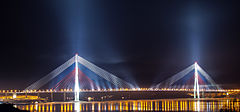Cable-stayed bridges

The Russky Bridge's central span measures 1104 meters. It is the world's longest cable-stayed bridge.
|
|
| Ancestor | Suspension bridge |
|---|---|
| Related | Extradosed bridge |
| Descendant | Side-spar cable-stayed bridge, Self-anchored suspension bridge, cantilever spar cable-stayed bridge |
| Carries | Pedestrians, bicycles, automobiles, trucks, light rail |
| Span range | Medium to Long |
| Material | Steel rope, post-tensioned concrete box girders, steel or concrete pylons |
| Movable | No. |
| Design effort | medium |
| Falsework required | Normally none |
A cable-stayed bridge has one or more towers (or pylons), from which cables support the bridge deck. A distinctive feature are the cables which run directly from the tower to the deck, normally forming a fan-like pattern or a series of parallel lines. This is in contrast to the modern suspension bridge, where the cables supporting the deck are suspended vertically from the main cable, anchored at both ends of the bridge and running between the towers. The cable-stayed bridge is optimal for spans longer than cantilever bridges, and shorter than suspension bridges. This is the range where cantilever bridges would rapidly grow heavier if the span were lengthened, while suspension bridge cabling would not be more economical if the span were shortened.
Cable-stayed bridges have been known since the 16th century and used widely since the 19th. Early examples often combined features from both the cable-stayed and suspension designs, including the famous Brooklyn Bridge. The design fell from favor through the 20th century as larger gaps were bridged using pure suspension designs, and shorter ones using various systems built of reinforced concrete. It once again rose to prominence in the later 20th century when the combination of new materials, larger construction machinery, and the need to replace older bridges all lowered the relative price of these designs.
Cable-stayed bridges date back to 1595, where designs were found in Machinae Novae, a book by Venetian inventor Fausto Veranzio. Many early suspension bridges were cable-stayed construction, including the 1817 footbridge Dryburgh Abbey Bridge, James Dredge's patented Victoria Bridge, Bath (1836), and the later Albert Bridge (1872) and Brooklyn Bridge (1883). Their designers found that the combination of technologies created a stiffer bridge. John A. Roebling took particular advantage of this to limit deformations due to railway loads in the Niagara Falls Suspension Bridge.
...
Wikipedia
